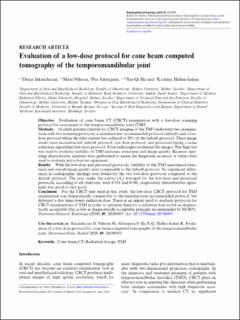| dc.contributor.author | Iskanderani, Durer | |
| dc.contributor.author | Nilsson, Mats | |
| dc.contributor.author | Alstergren, Per | |
| dc.contributor.author | Shi, Xie-Qi | |
| dc.contributor.author | Hellén-halme, Kristina | |
| dc.date.accessioned | 2021-04-20T08:02:23Z | |
| dc.date.available | 2021-04-20T08:02:23Z | |
| dc.date.created | 2020-08-04T17:00:33Z | |
| dc.date.issued | 2020 | |
| dc.identifier.issn | 0250-832X | |
| dc.identifier.uri | https://hdl.handle.net/11250/2738502 | |
| dc.description.abstract | Objective:
Evaluation of cone beam CT (CBCT) examination with a low-dose scanning protocol for assessment of the temporomandibular joint (TMJ).
Methods:
34 adult patients referred for CBCT imaging of the TMJ underwent two examinations with two scanning protocols, a manufacturer-recommended protocol (default) and a low-dose protocol where the tube current was reduced to 20% of the default protocol. Three image stacks were reconstructed: default protocol, low-dose protocol, and processed (using a noise reduction algorithm) low-dose protocol. Four radiologists evaluated the images. The Sign test was used to evaluate visibility of TMJ anatomic structures and image quality. Receiver operating characteristic analyzes were performed to assess the diagnostic accuracy. κ values were used to evaluate intraobserver agreement.
Results:
With the low-dose and processed protocols, visibility of the TMJ anatomical structures and overall image quality were comparable to the default protocol. No significant differences in radiographic findings were found for the two low-dose protocols compared to the default protocol. The area under the curves (Az) averaged for the low-dose and processed protocols, according to all observers, were 0.931 and 0.941, respectively. Intraobserver agreement was good to very good.
Conclusion:
For the CBCT unit used in this study, the low-dose CBCT protocol for TMJ examination was diagnostically comparable to the manufacturer-recommended protocol, but delivered a five times lower radiation dose. There is an urgent need to evaluate protocols for CBCT examinations of TMJ in order to optimize them for a radiation dose as low as diagnostically acceptable (the as low as diagnostically acceptable principle recommended by NCRP). | en_US |
| dc.language.iso | eng | en_US |
| dc.publisher | British Institute of Radiology | en_US |
| dc.rights | Navngivelse 4.0 Internasjonal | * |
| dc.rights.uri | http://creativecommons.org/licenses/by/4.0/deed.no | * |
| dc.title | Evaluation of a low-dose protocol for cone beam computed tomography of the temporomandibular joint | en_US |
| dc.type | Journal article | en_US |
| dc.type | Peer reviewed | en_US |
| dc.description.version | publishedVersion | en_US |
| dc.rights.holder | Copyright 2020 The Authors | en_US |
| dc.source.articlenumber | 20190495 | en_US |
| cristin.ispublished | true | |
| cristin.fulltext | original | |
| cristin.qualitycode | 1 | |
| dc.identifier.doi | 10.1259/dmfr.20190495 | |
| dc.identifier.cristin | 1821647 | |
| dc.source.journal | Dentomaxillofacial Radiology | en_US |
| dc.identifier.citation | Dentomaxillofacial Radiology. 2020, 49 (6), 20190495. | en_US |
| dc.source.volume | 49 | en_US |
| dc.source.issue | 6 | en_US |

